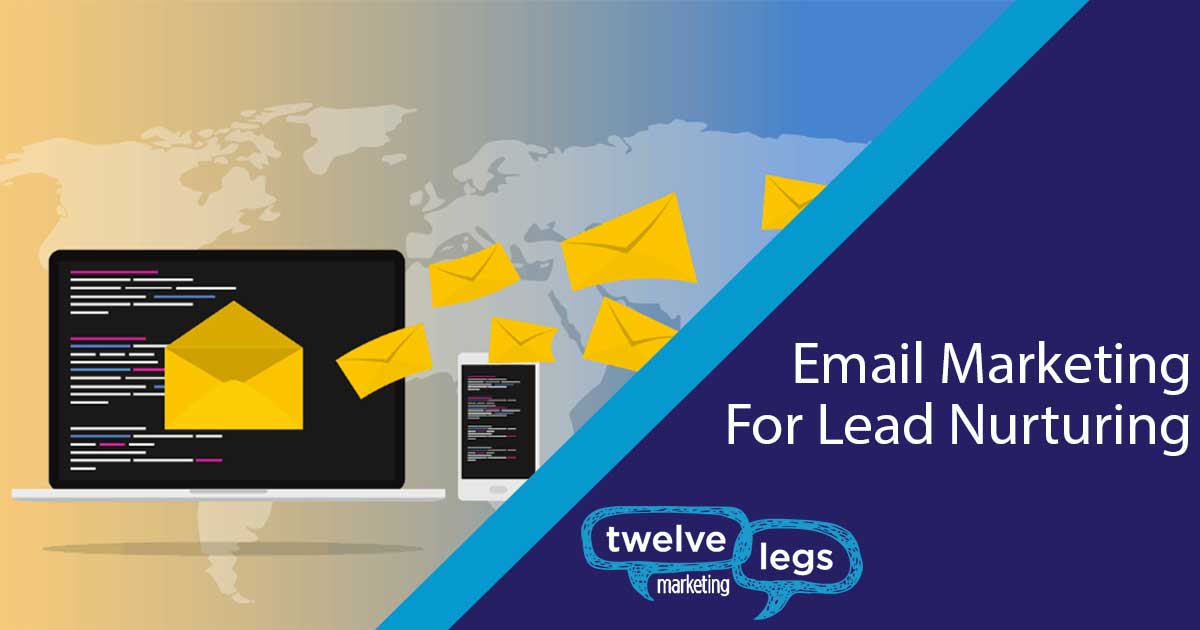Email Marketing For Lead Nurturing

nur·ture /nərCHər/ – the process of caring for and encouraging the growth or development of someone or something.
Not all leads are created equal. In fact, about 75% of leads in any marketing funnel are not ready to buy.

Let’s say someone comes to your site and downloads a free ebook. In order to get the content, they fill out your landing page form, providing you some basic info (name, email, maybe even a phone number and some insightful comments). Wisely, you’ve planned ahead and while the ebook itself is “free,” you’ve captured valuable information in return.
Now you have a lead.
“The Glengarry leads are for closers only…”
Better yet, you have a potential customer.
But as we’ve established, unless they’re in the minority, they’re not going to make a purchase.
They must be educated…informed…motivated. They must be nurtured.
Why Is Email Lead Nurturing Important?
Because while they may not be ready to invest in your product/service right now, they could be your ideal buyer in the future.
In fact, according to Hubspot, 74% of companies say that converting leads to customers is their top priority. Here are some other eye-popping statistics that underscore the importance of lead nurturing:
- 96% of visitors who come to your website aren’t ready to buy…yet (Marketo)
- Gleanster reports that 15-20% of the “not yet ready to purchase” opportunities converted into sales with lead nurturing
- Lead nurturing emails get 4-10 times the response rate compared to standalone email blasts (DemandGen Report)
- 74% of top-performing companies use automated lead nurturing (Gleanster)
- Nurtured leads produce an average 20% increase in sales opportunities versus non-nurtured leads (Demand Gen Report, 2014)
Lead Nurturing Made Simple(r) in the Digital Age
CRM, email tracking, marketing automation, oh my!
Hard to believe there was a time when lead nurturing was a manual process.

With decades of digital marketing experience, we at Twelve Legs have access to robust drip marketing tools and techniques that can keep leads engaged and moving through your sales funnel. Set up the canvas, identify content and key messaging points to communicate throughout, then press play. And based on performance, it’s quite easy to make adjustments on the fly, digitally speaking.
It can all be done at a relatively low cost, too, when you eliminate much of the overhead.
Are Your CRM Data Insights Maximized?
In order to run an automated email nurture campaign, your leads will need to be collected and categorized in some sort of system or database.
According to Eloqua, Taleo Corporation saw many benefits to their database through lead nurturing:
- Increased the number of opportunities entering the pipeline by 118%
- Nearly eliminated “unrated” leads from their database
- Improved conversion rates at every stage of the funnel
- Saw an additional 30% of visitors convert to marketing qualified leads
If you have customer relationship management (CRM) software in place, excellent. Now it’s time to make sure your contacts are all polished up.
Successful marketers should always have a steady stream of leads entering their database. So it’s important to keep it as clean and accurate as possible.
Identify your high/low priority leads, and remove all the ones that are fruitless and illegitimate—because a solid lead nurturing campaign starts with an audit of your database and careful review of each new lead to determine:
- Is the contact info is accurate?
- Did they share key purchasing preferences/details?
- Did they fill out more than one lead capture form?
- Do they interact with your content regularly?
The more “yes” responses each prospect elicits, the hotter the lead. When you’ve completed your database audit and vetted your leads, it’s time to categorize!
Adding Leads to Email Nurture Campaigns
If you’re getting the most out of your CRM, you’re probably increasing online conversion rates.
Start by creating categories that put each lead group on its own unique nurture path.

For example, if a lead didn’t provide many specifics, and commented that they’re “at least 12 months away from a potential purchase,” they may be tagged as “Long Cycle Leads” and placed into a more general nurture campaign. Their journey starts with awareness—it’s your job to stay top-of-mind with gentle reminders and relevant content that showcase the best aspects of your brand. This could go on for months. Make it hard for them to ignore you…not by browbeating, but with a compelling email once or twice a month. Simply keep them informed and be on their radar when they’re ready.
If a lead is expressing interest in your product/service through multiple capture forms and notes a few challenges they/their organization face, you might create a bucket for leads who share common pain points. The nurture campaign here can be a little more specific and aggressive, always highlighting the ways you can alleviate their “pain.”
You can get as granular as you’d like when it comes to categorizing leads, really.
For most marketers, a few nurture paths will suffice, based on the level of engagement demonstrated by different leads.
Using the form submission info you gather, and knowledge of how often they interact with your content (website, email newsletters, social media, resource downloads, etc.) can determine if the lead is “highly engaged,” “somewhat engaged,” “minimally engaged,” and so on. Each group can enter a different nurture campaign with targeted content, messaging, and calls-to-action.
Types of Lead Nurturing Emails
Each prospect’s situation will be different, and while your specific nurture campaign should account for that, the structure of your campaigns can be consistent. For automated drip campaigns, find a template that works for each type of email you’re sending at each stage, and tailor the content and message based on the group of leads you’re communicating with.
As an example, here’s a simple series of email types that could be set up to move a “somewhat engaged” lead to “very engaged/ready to convert” lead throughout a campaign spanning just a few weeks.
- Awareness Email: At this stage, they want to be educated with resources, research data, and insight. Send them a Newsletter email that spotlights some relevant content and news about your product/service/brand. Right now your prospect is looking for answers.
- Consideration Email: They’re starting to get more serious with more intensive research on whether or not your offerings could be a good fit. Send them a Multimedia email featuring a blog post, promotional video, and/or tangible resource.
- Decision Email: They want to know exactly what it will take to buy from you, and why they should choose you over your competition. Send them an Offer email with a clear CTA to “buy now,” or “give us a try with this special offer,” or “set up a consultation.”
According to the Aberdeen Group, companies who effectively nurture their customer through the buying experience have:
- 54% greater return on marketing investment
- 5 times greater revenue from referrals
- 18 times faster sales cycles
Always Measure and Analyze Your Email Nurture Campaigns
What you don’t want to do with your nurture campaign is set it and forget it.
Carefully monitoring opens, clicks, and click through rates is important for each nurture campaign you deploy.
If you have the capacity, this will allow you to set up triggers for more nuanced follow-up emails and nurture paths depending on the actions each lead takes as a result of your communication.
Ultimately, your nurture campaign will inform whether you move on completely from a lead, optimize your campaign to further engage a lead, or contact a lead with your ironclad sales pitch!
An effective nurture campaign speaks to the needs and concerns of a prospective buyer while taking them on a journey. A journey that hopefully enlightens them with all the things that differentiate your product and ends with a closed sale, happy customer, and brand ambassador for years to come.



